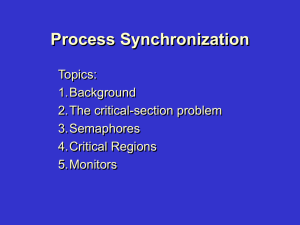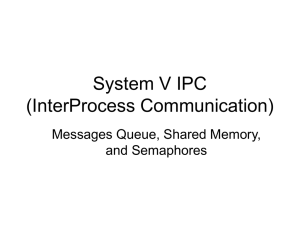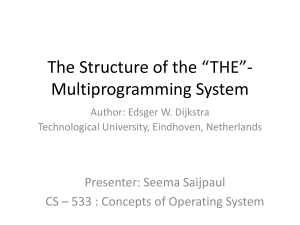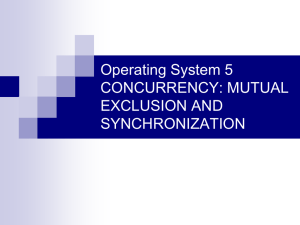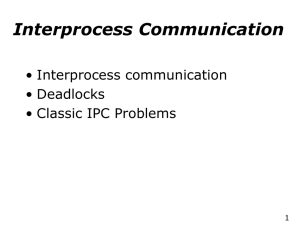07_feb_Chapter_6_Process_Syn
advertisement
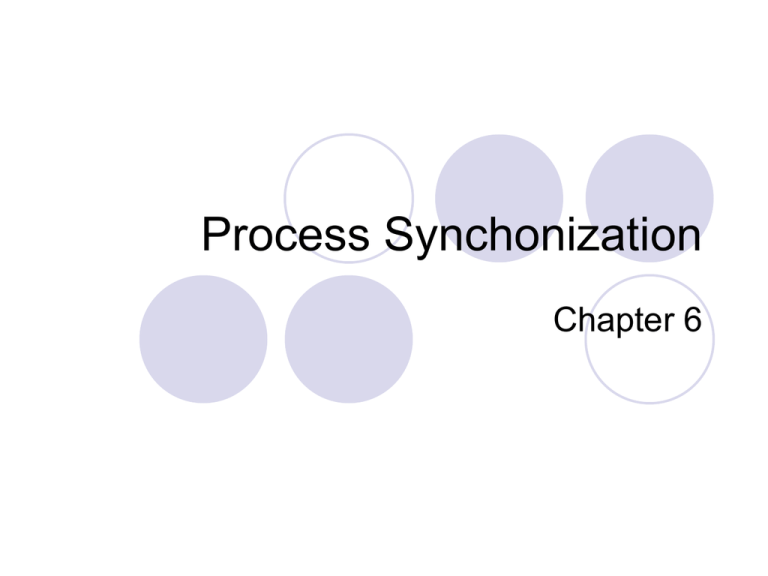
Process Synchonization
Chapter 6
Outline
Process Synchronization
The Critical-Section Problem
Peterson’s Solution
Synchronization Hardware
Semaphores
Implementation
Deadlocks and Starvation
Classic Problems of Synchronization
The Bounded-Buffer Problem
The Readers-Writers Problem
The Dining-Philosophers problem
Process
Synchronization
Cooperating Processes
That can affect or be affected by other
processes executing in the system.
Concurrent access to shared data may result in
data inconsistency.
Maintaining data consistency requires
mechanisms to ensure that cooperating processes
access shared data sequentially.
Bounded-Buffer Problem
Shared data
#define BUFFER_SIZE 10
typedef struct {
...
} item;
item buffer[BUFFER_SIZE];
int in = 0, out = 0;
int counter = 0;
Bounded-Buffer Problem
Producer process
item nextProduced;
…
while (1) {
while (counter == BUFFER_SIZE) ;
buffer[in] = nextProduced;
in = (in + 1) % BUFFER_SIZE;
counter++;
}
Bounded-Buffer Problem
Consumer process
item nextConsumed;
while (1) {
while (counter == 0) ;
nextConsumed = buffer[out];
out = (out + 1) % BUFFER_SIZE;
counter--;
}
Bounded-Buffer Problem
“counter++” in assembly
language
MOV R1, counter
INC R1
MOV counter, R1
“counter--” in assembly language
MOV R2, counter
DEC R2
MOV counter, R2
Bounded-Buffer Problem
If both the producer and consumer
attempt to update the buffer
concurrently, the machine language
statements may get interleaved.
Interleaving depends upon how the
producer and consumer processes
are scheduled.
Bounded-Buffer Problem
Assume counter is initially 5. One
interleaving of statements is:
producer:
MOV
INC
consumer: MOV
DEC
producer: MOV
consumer: MOV
R1, counter
R1
R2, counter
R2
counter, R1
counter, R2
(R1 = 5)
(R1 = 6)
(R2 = 5)
(R2 = 4)
(counter = 6)
(counter = 4)
The value of count may be either 4 or 6,
where the correct result should be 5.
Process
Synchronization
Race Condition: The situation
where several processes access
and manipulate shared data
concurrently, the final value of the
data depends on which process
finishes last.
Process
Synchronization
Critical Section: A piece of code
in a cooperating process in which
the process may updates shared
data (variable, file, database, etc.).
Critical Section Problem:
Serialize executions of critical
sections in cooperating processes
Process
Synchronization
More Examples
Bank transactions
Airline reservation
Bank Transactions
D
Deposit
Balance
W
Withdrawal
MOV A, Balance
MOV B, Balance
ADD A, Deposited
SUB B, Withdrawn
MOV Balance, A
MOV Balance, B
Bank Transactions
Bank Transactions
Current balance = Rs. 50,000
Check deposited = Rs. 10,000
ATM withdrawn = Rs. 5,000
Bank Transactions
Check Deposit:
MOV A, Balance
ADD A, Deposit ed
// A = 50,000
// A = 60,000
ATM Withdrawal:
MOV B, Balance
SUB B, Withdrawn
// B = 50,000
// B = 45,000
Check Deposit:
MOV Balance, A
// Balance = 60,000
ATM Withdrawal:
MOV Balance, B
// Balance = 45,000
Assembly Language usage in C++ compiler
#include <iostream.h>
main()
{
int c = 5;
__asm {
mov eax,c
mov ebx,10
add eax,ebx
mov c,eax
}
cout << c << endl;
}
#include <iostream.h>
main()
{
int c = 0;
__asm {
mov eax,c
add eax,1
mov c,eax
}
cout << c << endl;
}
Solution of the Critical
Problem
Software based solutions
Hardware based solutions
Operating system based
solution
Structure of Solution
do {
entry section
critical section
exit section
reminder section
} while (1);
Solution to Critical-Section
Problem
2-Process Critical Section Problem
N-Process Critical Section Problem
Conditions for a good solution:
1. Mutual Exclusion: If a process is
executing in its critical section, then
no other processes can be executing
in their critical sections.
Solution to CriticalSection Problem
2. Progress: If no process is
executing in its critical section and
some processes wish to enter their
critical sections, then only those
processes that are not executing in
their remainder sections can
decide which process will enter its
critical section next, and this
decision cannot be postponed
indefinitely.
Solution to CriticalSection Problem
3. Bounded Waiting: A bound must
exist on the number of times that
other processes are allowed to
enter their critical sections after a
process has made a request to
enter its critical section and before
that request is granted.
Solution to CriticalSection Problem
Assumptions
Assume that each process
executes at a nonzero speed
No assumption can be made
regarding the relative speeds
of the N processes.
Possible Solutions
Only 2 processes, P0 and P1
Processes may share some common
variables to synchronize their actions.
General structure of process Pi
do {
entry section
critical section
exit section
remainder section
} while (1);
Algorithm 1
Shared variables:
int turn;
initially turn = 0
turn = i Pi can enter its
critical section
Algorithm 1
Process Pi
do {
while (turn != i)
;
critical section
turn = j;
remainder section
} while (1);
Does not satisfy the progress condition
Only two processes (P0 and P1)
executing
concurrently
Process P0
do {
while (turn != 0) ;
critical section
turn = 1;
reminder section
} while (1);
Process P1
do {
while (turn != 1) ;
critical section
turn = 0;
reminder section
} while (1);
P0 executes first, enters the critical region… and leaves it, leaving turn = 1.
Turn = 1 means P1 can enter the critical region, and finishes the critical
section quickly, now turn = 0.
P0 enters the loop and finishes its critical region quickly. Giving turn to P1
(turn = 1)
At this point as we assumed that there is no process speed considerations
say process P0 gets ready to run again while P1 (Turn=1) is still in its
remainder section.
P0 cannot enters it critical region because Turn = 1.
Violation of Condition (2. Progress)
Algorithm 2
Shared variables
boolean flag[2]; // Set to false
flag [i] = true Pi ready to
enter its critical section
Algorithm 2
Process Pi
do {
flag[i] = true;
while (flag[j])
;
critical section
flag[i] = false;
remainder section
} while (1);
Does not satisfy the progress condition
Problem!!!!!
Process P0
do {
flag[0] := true;
while (flag[1]) ;
critical section
flag [0] = false;
remainder section
} while (1);
Process P1
do {
flag[1] := true;
while (flag[0]) ;
critical section
flag [1] = false;
remainder section
} while (1);
Tx: P0 sets flag[0] true to enter its region
Ty: P1 sets its flag i.e. flag[1] to true to
enter its region
A Deadlock!!!!!
Both will wait forever to enter their regions.
Algorithm 3
Combined shared variables of
algorithms 1 and 2.
boolean flag[2]; // Set to false
int turn=0;
Algorithm 3
Process Pi
do {
flag[i] = true;
turn = j;
while (flag[j] && turn == j) ;
critical section
flag[i] = false;
remainder section
} while (1);
Algorithm 3
Meets all three requirements:
Mutual Exclusion: ‘turn’ can
have one value at a given time
(0 or 1)
Bounded-waiting: At most
one entry by a process and
then the second process
enters into its CS
Algorithm 3
Progress: Exiting process sets
its ‘flag’ to false … comes back
quickly and set it to true
again … but sets turn to the
number of the other process
Process Pi
do {
flag [0]:= true;
turn = 1;
while (flag [1] and turn = 1) ;
critical section
flag [0] = false;
remainder section
} while (1);
Process Pi
do {
flag [1]:= true;
turn = 0;
while (flag [0] and turn = 0) ;
critical section
flag [1] = false;
remainder section
} while (1);
Meets all the requirements
Solves critical section problem of the two
processes
n-Process Critical Section
Problem
Consider a system of n
processes (P0, P1 ... Pn-1).
Each process has a segment
of code called a critical section
in which the process may
change shared data.
n-Process Critical Section
Problem
When one process is executing
its critical section, no other
process is allowed to execute in
its critical section.
The critical section problem is to
design a protocol to serialize
executions of critical sections.
Bakery Algorithm
By Leslie Lamport
Before entering its critical section,
process receives a ticket number.
Holder of the smallest ticket
number enters the critical section.
If processes Pi and Pj receive the
same number, if i < j, then Pi is
served first; else Pj is served first.
Bakery Algorithm
The ticket numbering
scheme always generates
numbers in the increasing
order of enumeration; i.e.,
1, 2, 3, 4, 5 ...
Bakery Algorithm
Notations
(ticket #, process id #)
(a,b) < (c,d) if a < c or
if a == c and b < d
max (a0,…, an-1) is a number, k,
such that k ai for i = 0, …, n–1
Bakery Algorithm
Data Structures
boolean choosing[n];
int number[n];
These data structures are
initialized to false and 0,
respectively
Bakery Algorithm
Structure of Pi
do {
choosing[i] = true;
number[i] = max(number[0],
number[1], …,
number [n – 1]) + 1;
choosing[i] = false;
Bakery Algorithm
for (j = 0; j < n; j++) {
while (choosing[j]) ;
while ( (number[j] != 0) &&
((number[j], j) < (number[i], i)) ) ;
}
Critical Section
Bakery Algorithm
number[i] = 0;
remainder section
} while (1);
Bakery Algorithm
do {
choosing[i] = true;
number[i] = max(number[0], number[1], …, number
[n – 1])+1;
choosing[i] = false;
for (j = 0; j < n; j++) {
while (choosing[j]) ;
while ((number[j] != 0) && (number[j,j] <
number[i,i])) ;
}
critical section
number[i] = 0;
remainder section
} while (1);
Bakery Algorithm
Process Number
P0
3
P1
0
P2
7
P3
4
P4
8
Bakery Algorithm
P0
P2
P3
P4
(3,0) < (3,0) (3,0) < (7,2) (3,0) < (4,3) (3,0) < (8,4)
Number[1] = 0 Number[1] = 0 Number[1] = 0 Number[1] = 0
(7,2) < (3,0) (7,2) < (7,2) (7,2) < (4,3) (7,2) < (8,4)
(4,3) < (3,0) (4,3) < (7,2) (4,3) < (4,3) (4,3) < (8,4)
(8,4) < (3,0) (8,4) < (7,2) (8,4) < (4,3) (8,4) < (8,4)
Bakery Algorithm
P1 not interested to get into its
critical section number[1] is 0
P2, P3, and P4 wait for P0
P0 gets into its CS, get out, and
sets its number to 0
P3 get into its CS and P2 and P4
wait for it to get out of its CS
Bakery Algorithm
P2 gets into its CS and P4 waits
for it to get out
P4 gets into its CS
Sequence of execution of
processes:
<P0, P3, P2, P4>
Bakery Algorithm
Meets all three requirements:
Mutual Exclusion:
(number[j], j) < (number[i], i) cannot be
true for both Pi and Pj
Bounded-waiting: At most one
entry by each process (n-1
processes) and then a requesting
process enters its critical section
(First-Come-First-Serve)
Bakery Algorithm
Progress:
Decision takes complete
execution of the ‘for loop’ by
one process
No process in its ‘Remainder
Section’ (with its number set to
0) participates in the decision
making
Synchronization Hardware
Bakery algorithm is very difficult to
implement. Next attempt was to solve issues
with a little help of Hardware
Two methods
Disable Interrupts
Special Hardware Instructions
Synchronization
Hardware
Normally, access to a memory
location excludes other accesses to
that same location.
Extension: designers have
proposed machine instructions that
perform two operations atomically
(indivisibly) on the same memory
location (e.g., reading and writing).
Synchronization
Hardware
The execution of such an instruction
is also mutually exclusive (even on
Multiprocessors).
They can be used to provide mutual
exclusion but other mechanisms are
needed to satisfy the other two
requirements of a good solution to
the CS problem.
Test-And-Set (TSL)
Instruction
Test and modify a word atomically.
boolean TestAndSet(boolean &target)
{
boolean rv = target;
target = true;
return rv;
}
2015年4月13日星期一
© Copyright Virtual University of Pakistan
Solution with TSL
Structure for Pi (‘lock’ is set to false)
do {
while ( TestAndSet(lock) ) ;
Critical Section
lock = false;
Remainder Section
2015年4月13日星期一
}
© Copyright Virtual University of Pakistan
Solution with TSL
Is the TSL-based solution good?
No
Mutual Exclusion: Satisfied
Progress: Satisfied
Bounded Waiting: Not satisfied
Swap Instruction
Swaps two variables atomically
void swap (boolean &a, boolean &b)
{
boolean temp = a;
a = b;
b = temp;
}
2015年4月13日星期一
© Copyright Virtual University of Pakistan
Solution with Swap
Structure for Pi
‘key’ is local and set to false
do {
key = true;
while (key == true) swap(lock,key);
Critical Section
}
lock = false;
Remainder Section
2015年4月13日星期一
© Copyright Virtual University of Pakistan
Solution with swap
Is the swap-based solution good?
No
Mutual Exclusion: Satisfied
Progress: Satisfied
Bounded Waiting: Not satisfied
A Good Solution
‘key’ local; ‘lock’ and ‘waiting’
global
All variables set to false
do {
waiting[i] = true;
key = true;
while (waiting[i] && key)
key = TestAndSet(lock);
waiting[i] = false;
2015年4月13日星期一
© Copyright Virtual University of Pakistan
Critical Section
A Good Solution
j = (i+1) % n;
while ( (j != i) && !waiting[j] )
j = (j+1) % n;
if (j == i)
lock = false;
else
waiting[j] = false;
}
2015年4月13日星期一
Remainder Section
© Copyright Virtual University of Pakistan
Solution with
Test-And-Set
Is the given solution good?
Yes
Mutual Exclusion: Satisfied
Progress: Satisfied
Bounded Waiting: Satisfied
Outline
Process Synchronization
The Critical-Section Problem
Peterson’s Solution
Synchronization Hardware
Semaphores
Implementation
Deadlocks and Starvation
Classic Problems of Synchronization
The Bounded-Buffer Problem
The Readers-Writers Problem
The Dining-Philosophers problem
Semaphores
Semaphores
Synchronization tool
Available in operating systems
Semaphore S – integer variable
that can only be accessed via
two indivisible (atomic)
operations, called wait and
signal
Semaphores
Synchronization tool.
Semaphore S – integer variable
Can only be accessed via two indivisible (atomic)
operations.
wait (S):
while S 0 do no-op;
S--;
signal (S):
S++;
Single CPU system disable all interrupts when executing
Wait and Signal
Multiple CPU systems protect semaphore by TSL ..
Two Types of Semaphores
Counting semaphore – integer value
(S) can range over an unrestricted
domain.
Binary semaphore – integer value can
range only between 0 and 1; can be
simpler to implement.
Can implement a counting semaphore S
as a binary semaphore.
Semaphores
wait(S){
while S 0
; //no-op
S--;
}
signal(S){
S++;
}
n-Processes CS Problem
Shared data:
semaphore mutex = 1;
do {
wait(mutex);
critical section
signal(mutex);
remainder section
} while (1);
Remember wait and signal are atomic
P0
do {
wait(mutex);
critical section
signal(mutex);
remainder
section
} while (1);
P1
do {
wait(mutex);
critical section
signal(mutex);
remainder
section
} while (1);
Wait executes as one indivisible operation that once executing cannot be preempted
Same holds for Signal
If both Processes execute Wait(mutex) at same time then only one would get access
As Race condition would apply (wait and signal are atomic)
Is it a Good Solution?
Mutual Exclusion: Yes
Progress: Yes
Bounded Waiting: No
Semaphores
Mutexes
Mutex variable can have only two states..
Locked and Unlocked
Good when only mutual exclusion is required
If lock is 0 any process may set it to 1 using TSL
instruction and then READ or WRITE Shared
data
If lock is 1 then process may set it to 1 using
TSL (note no effect on lock state) and then
Compare if it was 0 or not. It was non-zero (1) in
this case hence process loops to check the state
of the lock.
Mutex Code in Assembly
Enter_region:
TSL Rx, Mutex
CMP RX, 0
JZE ok
CALL Thread_Yield
JMP enter_region
//get lock value in Rx and Set lock to 1
//Compare old value of Lock with 0
//It was 0 hence enter critical region
//If already 1 then loop to enter_region
RET
//If Lock was 0 then return and enter critical region
OK
Leave_region:
MOV MUTEX, 0
RET
//Set lock to 0 so other waiting or looping process may enter
Busy Waiting
Processes wait by executing
CPU instructions
Problem? Wasted CPU cycles
Solution? Modify the definition
of semaphore
Semaphore
Implementation
Define a semaphore as a record
typedef struct {
int value;
struct process *L;
} semaphore;
Semaphore
Implementation
Assume two simple operations:
block() suspends the
process that invokes it.
wakeup(P) resumes the
execution of a blocked process
P.
Semaphore
Implementation
The negative value of S.value
indicates the number of
processes waiting for the
semaphore
A pointer in the PCB needed to
maintain a queue of processes
waiting for a semaphore
Semaphore wait()
Semaphore operations now
defined as
void wait(semaphore S){
S.value--;
if (S.value < 0) {
add this process to S.L;
block();
}
}
Semaphore signal()
void signal(semaphore S){
S.value++;
if (S.value <= 0) {
remove process P from S.L;
wakeup(P);
}
}
There are numerous Win32 API’s
Block and Wakeup equivalent in win32 are ResumeThread(), SuspendThread,
WaitForSingleObject(), WaitForMultipleOjects() etc..
To create a semaphore variable
CSemaphore Object, CreateSemaphore() returns handle
Two Implementations
Busy-waiting version is better
when critical sections are small
and queue-waiting version is
better for long critical sections
(when waiting is for longer
periods of time).
Process Synchronization
Execute statement B in Pj only
after statement A has been
executed in Pi
Use semaphore S initialized to 0
Pi
Pj
A
wait(S)
signal(S)
B
Process Synchronization
Give a semaphore based solution
for the following problem:
Statement S1 in P1 executes only
after statement S2 in P2 has
executed, and statement S2 in P2
should execute only after
statement S3 in P3 has executed.
Process Synchronization
P1
P2
P3
S1
S2
S3
Solution
Semaphore A=0, B=0;
P1
wait(A)
S1
P2
wait(B)
S2
signal(A)
P3
S3
signal(B)
Problems with
Semaphores
Semaphores provide a powerful
tool for enforcing mutual
exclusion and coordinating
processes.
But wait(S) and signal(S) are
scattered among several
processes. Hence, difficult to
understand their effects.
Problems with
Semaphores
Usage must be correct in all the
processes.
One bad (or malicious) process
can fail the entire collection of
processes.
Deadlocks and
Starvation
A set of processes are said to be in
a deadlock state if every process is
waiting for an event that can be
caused only by another process in
the set.
Traffic deadlocks
One-way bridge-crossing
Starvation (infinite blocking) due to
unavailability of resources
Deadlock
P0
wait(S);
wait(Q);
signal(S);
signal(Q);
P1
wait(Q);
wait(S);
signal(Q);
signal(S);
Deadlock
signal(S);
P0
P1
signal(Q);
Starvation
(Infinite Blocking)
P0
wait(S);
wait(S);
P1
wait(S);
signal(S);
Violation of Mutual
Exclusion
P0
P1
signal(S); wait(S);
wait(S);
signal(S);
Main Cause of Problem
and Solution
Cause: Programming errors due
to the tandem use of wait()
and signal() operations
Solution: Higher-level language
constructs such as critical region
(region statement) and monitor.
Producer consumer using
Semaphores
#define N 100
typedef int Semaphore;
//Any critical instruction be executed by a semaphore
Semaphore mutex =1, empty = N, full = 0;
void producer(void)
{
int item;
while (TRUE)
{
item = produce_item();
down(&empty);
down(&mutex);
insert_item(item);
up(&mutex);
up(&full);
}
}
Producer consumer using Semaphores …
void customer(void)
{
int item;
while(TRUE)
{
down(&full);
down(&mutex);
item = remove_item();
up(&mutex);
up(&empty);
consume_item(item);
}
}
Classical Problems of
Synchronization
Bounded-Buffer Problem
Do it yourself !
Readers and Writers Problem
Do it yourself
Dining-Philosophers Problem
See Next Slides: But do it yourself
Readers-Writers Problem
Shared data
semaphore mutex, wrt;
Initially
mutex = 1, wrt = 1, readcount = 0
Readers-Writers Problem Writer Process
wait(wrt);
…
writing is performed
…
signal(wrt);
Readers-Writers Problem Reader
Process
wait(mutex);
readcount++;
if (readcount == 1)
wait(wrt);
signal(mutex);
…
reading is performed
…
wait(mutex);
readcount--;
if (readcount == 0)
signal(wrt);
signal(mutex):
Dining-Philosophers Problem
Shared data
semaphore chopstick[5];
Initially all values are 1
Dining-Philosophers Problem
Philosopher i:
do {
wait(chopstick[i])
wait(chopstick[(i+1) % 5])
…
eat()
…
signal(chopstick[i]);
signal(chopstick[(i+1) % 5]);
…
think
…
} while (1);
Deadlock can occur if all the philosophers become hungry at the same time
Semaphores in Win32
CreateSemahore()
WaitForSingleObject()
ReleaseSemahore()
How to use Semaphores
HANDLE hs
hs= CreateSemaphore
( NULL, // no security attributes
InitialValue, // initial count .. For binary cMax =1
MaxValue, // maximum count .. For binary cMax =1
NULL); // pointer to semaphore-object name
WaitForSingleObject(hs,INFINITE);
count++; //simulation of critical region
ReleaseSemaphore(hs,1,NULL);
Monitors
Continuation of idea of ``object'' and object-oriented
programming, abstract data types, data
encapsulation, software engineering
Monitor contains programmer-defined operations
that are provided mutual exclusion within the monitor
Only one process can be active inside a monitor
Programmer doesn’t need to code synchronization
explicitly
Integral part of the programming language so the
compiler can generate the correct code to implement
the monitor using the programming language runtime support
Monitors
monitor monitor-name
{
shared variable declarations
procedure body P1 (…) {
...
}
procedure body P2 (…) {
...
}
procedure body Pn (…) {
...
}
{
initialization code
}
}
Monitors… What if programmer wants explicit
Synchronization
To allow a process to wait within the monitor, a condition
variable must be declared, as
condition x, y;
Condition variable can only be used with the operations
wait and signal.
The operation
x.wait();
means that the process invoking this operation is suspended until
another process invokes
x.signal();
The x.signal operation resumes exactly one suspended process.
If no process is suspended, then the signal operation has no
effect.
Normally x.signal resumes the process which first issued x.wait()
Dining Philosophers Example
monitor dp
{
enum {thinking, hungry, eating} state[5];
condition self[5];
void pickup(int i)
// following slides
void putdown(int i) // following slides
void test(int i)
// following slides
void init()
{
for (int i = 0; i < 5; i++)
state[i] = thinking;
}
}
Dining Philosophers
void pickup(int i)
{
state[i] = hungry;
test[i];
if (state[i] != eating)
self[i].wait();
}
void putdown(int i)
{
state[i] = thinking;
// test left and right neighbors
test((i+4) % 5);
test((i+1) % 5);
}
Philosopher issues pickup() when
It wants to eat. In this code it also
Checks if chopsticks are available
Putdown is used after eating
Dining Philosophers
void test(int i)
{
if ( (state[(i + 4) % 5] != eating) &&
(state[i] == hungry) &&
(state[(i + 1) % 5] != eating))
{
state[i] = eating;
self[i].signal();
}
}
Check the states of neighboring philosophers. They must not be eating
i.e. must not be in critical region.
Dining Philosophers Example
Code is now simple. Dinning philospher
picks up the chop sticks and if they are not
available it waits
Dp.pickup(i)
Eat
Do.putdown(i)
Interesting Reading… Sec 2.3 Tanenbaum
Producer_Consumer Problem with
monitors.
Base Structure
Monitor ProducerConsumer
{
Function Consumer
Function Producer
Function InsertItem
Function RemoveItem
}
Monitor With Condition Variables
Windows 2000 Synchronization
Uses interrupt masks to protect access to
global resources on uniprocessor systems.
Uses spinlocks on multiprocessor
systems.
Dispatcher objects may also provide
events. An event acts much like a
condition variable.
END OF CHAPTER
Next:
Memory Management
